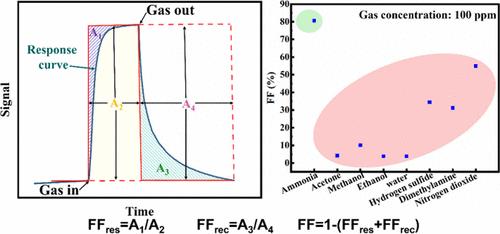Gas Sensor Selectivity Assessment Indicator of Fill Factor from Response Curve: A Case Study on WS2-Based Ammonia Gas Sensors
IF 9.1
1区 化学
Q1 CHEMISTRY, ANALYTICAL
引用次数: 0
Abstract
With the advancement of smart detection technologies, gas sensors have gained increasingly widespread applications in environmental monitoring, industrial safety, medical diagnostics, and intelligent agriculture. The response curve of a single gas sensor is conventionally used to calculate sensor performance evaluation parameters of response/recovery time and response value. The selectivity of a single sensor is currently evaluated by a selectivity coefficient based on the response value, which faces difficulty in distinguishing gases with different concentrations. In this study, a new metric of fill factor (FF) derived from response curve morphology features was introduced to offer a novel solution for single-sensor selectivity analysis. Three variants of the novel metrics, FFres (response phase fill factor), FFrec (recovery phase fill factor), and FF (total fill factor), can be calculated from the response curve. As a proof-of-concept, the FFs of WS2, WS2@PANI, and Au/PANI/WS2 sensors at different concentrations of ammonia, acetone, methanol, ethanol, and water vapor were calculated and used for gas selectivity analysis. Results demonstrated distinct FF ranges for ammonia and other gases, validating FF as a potential selectivity indicator. This approach provides a multidimensional analysis framework for enhanced single-sensor discrimination by constructing a parameter space incorporating curve morphology features.

响应曲线中填充因子的气体传感器选择性评价指标——以ws2型氨气体传感器为例
随着智能检测技术的进步,气体传感器在环境监测、工业安全、医疗诊断、智能农业等领域的应用越来越广泛。传统上使用单个气体传感器的响应曲线来计算传感器的响应/恢复时间和响应值等性能评价参数。目前单一传感器的选择性是通过基于响应值的选择系数来评价的,这在区分不同浓度的气体方面存在困难。在这项研究中,从响应曲线形态特征中引入了一个新的填充因子(FF)度量,为单传感器选择性分析提供了一种新的解决方案。新指标的三种变体,FFres(响应相位填充因子),FFrec(恢复相位填充因子)和FF(总填充因子),可以从响应曲线中计算出来。作为概念验证,计算了WS2、WS2@PANI和Au/PANI/WS2传感器在不同浓度的氨、丙酮、甲醇、乙醇和水蒸气下的FFs,并将其用于气体选择性分析。结果表明,氨和其他气体的FF范围明显,验证了FF作为潜在的选择性指标。该方法通过构造包含曲线形态特征的参数空间,为增强单传感器识别提供了多维分析框架。
本文章由计算机程序翻译,如有差异,请以英文原文为准。
求助全文
约1分钟内获得全文
求助全文
来源期刊

ACS Sensors
Chemical Engineering-Bioengineering
CiteScore
14.50
自引率
3.40%
发文量
372
期刊介绍:
ACS Sensors is a peer-reviewed research journal that focuses on the dissemination of new and original knowledge in the field of sensor science, particularly those that selectively sense chemical or biological species or processes. The journal covers a broad range of topics, including but not limited to biosensors, chemical sensors, gas sensors, intracellular sensors, single molecule sensors, cell chips, and microfluidic devices. It aims to publish articles that address conceptual advances in sensing technology applicable to various types of analytes or application papers that report on the use of existing sensing concepts in new ways or for new analytes.
 求助内容:
求助内容: 应助结果提醒方式:
应助结果提醒方式:


